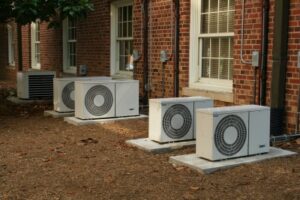You might not know much about industry-specific terms like SEER, but we promise you that SEER does impact your life, particularly in warmer clients like in Chesapeake, VA and Raleigh, NC.
SEER, or “Seasonal Energy Efficiency Ratio” is the standard HVAC techs use to gauge the energy efficiency of your cooling system. Think of it as the miles per gallon of your HVAC system.
The SEER is calculated by the cooling output for a usual cooling system divided by your total electric energy input of that season. The higher a SEER rating, the greater energy efficiency (and lower energy bills).
What Is the Range of Seer Ratings?
This is a fairly common question our North Carolina and Virginia clients ask us. By knowing the range, they believe they can have a better understanding of how well their AC is performing.
However, there is no set range for SEER ratings. That’s because the maximum SEER rating consistently increases as AC units become more and more efficient.
When our clients do ask us for advice in terms of SEER ratings, we often provide them with these benchmarks:
- An older air conditioner (10-15 years old) will typically have a SEER rating between 8-10
- 13 SEER is the minimum rating of ACs that you can purchase now
- The most efficient SEER ratings on the market today exceed 20
How Much Will a Business Owner or Homeowner in NC and VA Actually Save With a Higher Seer-Rated AC?
Before we give you the actually dollar savings, it’s important to know that your savings will depend on a variety of factors, including:
- The rates of your utility company
- How well you maintain your AC (we recommend yearly maintenance)
- The SEER rating of your current system
But, to help you visualize the impact of your SEER rating, let’s say that you’re:
- Upgrading from an 8 SEER to a 16 SEER
- Getting a new unit with a tonnage of 3 (the tonnage needed should be determined by a professional contractor)
- Being charged an electric rate of $0.080 per kilowatt
Using the energy savings calculator from NATE, you’ll discover that you’ll save, on average, $204 per year. You can use that calculation to determine how long it’ll take to break even when you purchase a higher rated AC.
Using SEER Ratings to Help You Make Decisions About Your AC Unit
SEER ratings are far more than just arbitrary numbers. We here at Comfort First use SEER ratings to help our clients determine if investing in a new unit will provide them the comfort and return on investment they deserve.
Sometimes, an AC unit merely needs minor repairs to regain most of its original glory. Assessing your current SEER rating will help our field technicians determine which steps are best to pursue in your quest for maintaining comfort in your home throughout the summer.
We also know that most of our clients don’t fully understand the complexities of SEER ratings and other industry-specific acronyms. That’s why we remain committed to speaking to you in normal English to help you understand the reasoning behind some of our recommendations.
In the end, every step we take and decision we make is focused on ensuring you and your family enjoy endless happy and healthy summers without investing more money into your HVAC system than you have to.
Learn more about determining your SEER rating and how much you can save per year with an upgrade by contacting ustoday!

 3x" class="mb-4 img-fluid h-auto position-relative z-index-9" alt="ribbon image" width="333" height="89">
3x" class="mb-4 img-fluid h-auto position-relative z-index-9" alt="ribbon image" width="333" height="89">














